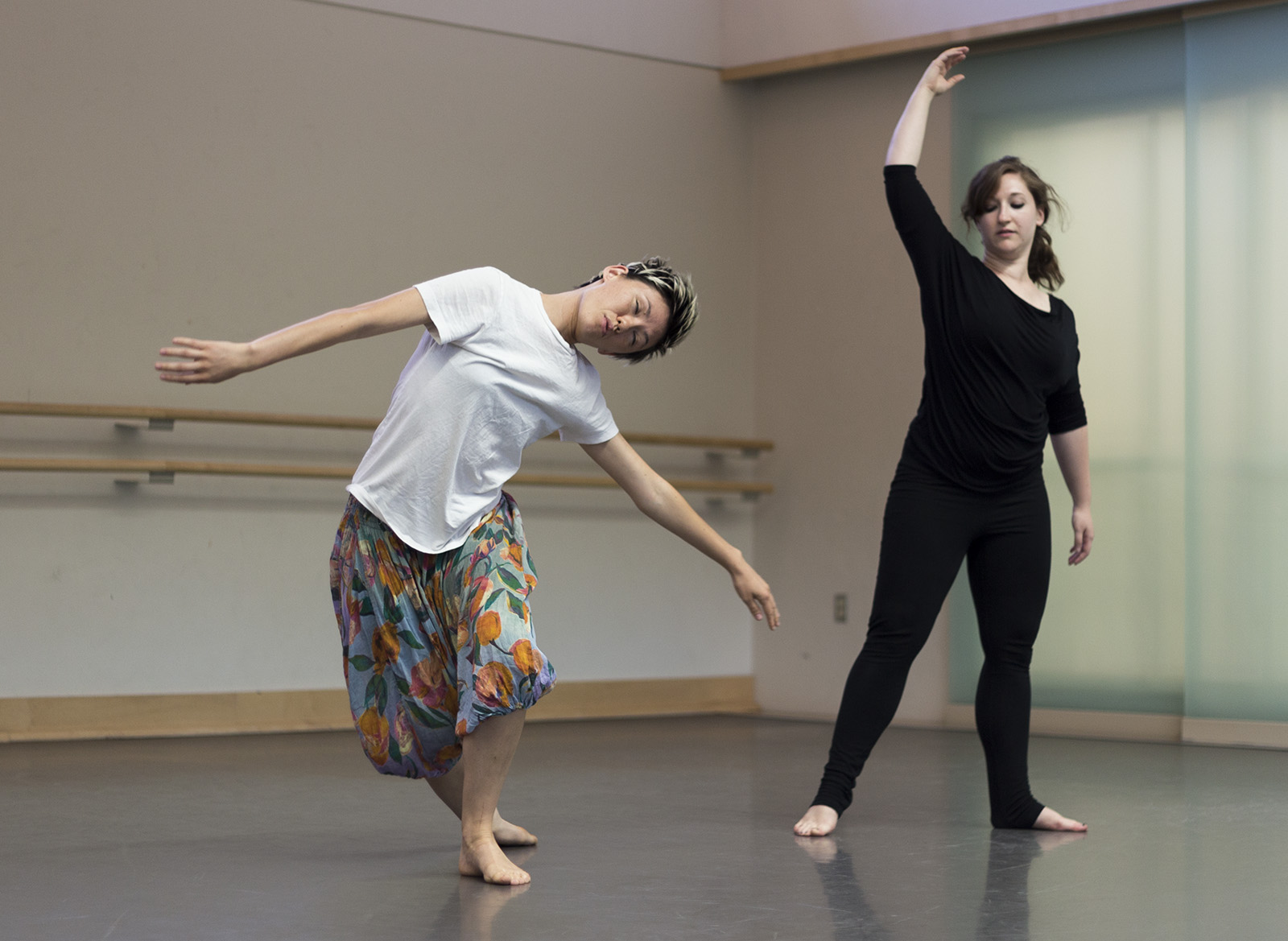Hothouse Residency provides LA dancers space to explore creative works

UCLA alumna Myrrhia Rodriguez (left) and Los Angeles performer Ali Kheradyar (right) are this year’s artists in residence for the Hothouse Residency. The program provides free dance studio space five days a week at UCLA during the summer. (Jennifer Hu/Daily Bruin)
By Samantha Suman
Sept. 4, 2016 10:47 p.m.
Los Angeles was not a dance-friendly town 21 years ago when Victoria Marks began teaching at UCLA. She said the entertainment industry’s enormous wealth hindered aspiring dance artists from affording rehearsal space in a city known for its involvement in movies.
“The expectation is that people have money to pay for rehearsal studios, but for artists who are not part of the entertainment industry, they are not part of this larger economy,” said Marks, world arts and cultures/dance vice chair of undergraduate affairs.
To solve this financial problem and to build a stronger LA dance community, Marks created Hothouse Residency 12 years ago. The three-week program is held once each summer, this year from Aug. 22 to Sept. 9. Hothouse Residency gives selected LA artists three and a half hours of studio time in the Glorya Kaufman Hall, Monday through Friday, for free — the only requirement is performing at an informal showcase Thursday.
Hothouse not only relieves the dancers of monetary burdens associated with using rented rehearsal space, but also allows them to explore their dance practices. In the past the program included eight to 10 artists; this year’s two artists in residence are Myrrhia Rodriguez, a UCLA dance alumna, and Ali Kheradyar, an LA performer from NYU’s Tisch School of the Arts.
Rodriguez began dancing at the age of three at the Curtis Studio of Dance in Carpinteria, California. After working in the fashion industry post-graduation, she returned to performing in summer 2015.
The UCLA alumna applied to the residency because rehearsal space in LA is expensive, especially when factoring in the time and money spent commuting to the studio.
The Hothouse Residency demands little of its participants, she said. Unlike other programs, she is not required to have a finished, full-length piece as a product of her three-week practice. Rather, she said she only needs to informally share her work with fellow artists, peers, mentors and students.
“We are given the keys, so to speak, and told to have fun,” Rodriguez said.
Rodriguez is using Hothouse to work on a piece she choreographed for a show she will perform at the Highways Performance Space and Gallery on Dec. 2 and 3.
“The piece felt like there were so many unanswered questions, so I’m using Hothouse to slowly unpack them again, workshop out and flesh out some of those ideas,” Rodriguez said.
Rodriguez is also learning a lot about her own art-making process as a choreographer, she said. The prolonged time she has in the studio allows her to accomplish more than she could if she were working under the condition of a daily space rental.
“I have this really lovely mindset and permission to take my time,” Rodriguez said. “I feel that has been a really big impact.”
Kheradyar, who received an MFA in art from California Institute of the Arts, applied to the Hothouse Residency because she, like Rodriguez, needed space to rehearse.
“(Hothouse) seemed like a really supportive environment that – if I were lucky enough to receive it – would be a really nice place to dive into a larger project,” Kheradyar said.
Kheradyar focuses on gender in her dance practice, specifically questioning how society has taught movement based on gender. She recently performed for U.N. Women LA at its “He for She” event. During her residency, she adapted Pina Bausch’s “Le Sacre du Printemps,” in which a woman is selected to be sacrificed and then dances to her death.
“I wanted to explore what it means to be a woman … and what it means to perform and re-perform death in dance,” Kheradyar said.
The Hothouse Residency program allowed Kheradyar to explore her physical and emotional limits as a dancer. She said the piece is extreme in nature because the choreography is demanding of her body. The dramatic, repetitive movements are physically exhausting, which Kheradyar said was intentionally done by Bausch to exemplify dancing to death on stage.
“It’s probably one of the most challenging pieces I’ve ever done,” Kheradyar said.
The Hothouse Residency program not only impacts the dancers, but Marks as well. She said the residency has helped her see herself as an advocate for others. The UCLA and Hothouse communities allow her to share the dancers’ excitement of discovering and creating new choreography,
“Every time a dancer gets to perform or gets to create a new work, they deepen their practice,” Marks said. “If (Hothouse) contributed to a number of artists’ evolutions in terms of their practice, then that is a great thing.”
Email Suman at [email protected].


